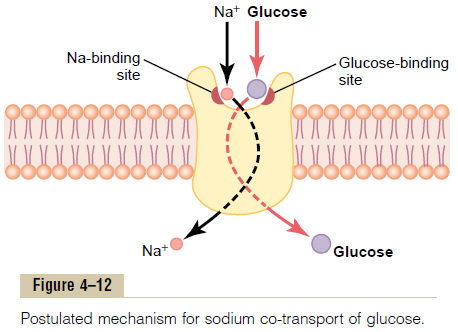Chapter: Medical Physiology: Membrane Physiology, Nerve, and Muscle : Transport of Substances Through the Cell Membrane
Secondary Active Transport - Co-Transport and Counter-Transport
Secondary Active Transport - Co-Transport and Counter-Transport
When sodium ions are transported out of cells by primary active transport, a large concentration gradient of sodium ions across the cell membrane usually develops—high concentration outside the cell and very low concentration inside. This gradient represents a storehouse of energy because the excess sodium outside the cell membrane is always attempting to diffuse to the interior. Under appropriate conditions, this diffusion energy of sodium can pull other sub-stances along with the sodium through the cell mem-brane. This phenomenon is called co-transport; it is one form of secondary active transport.
For sodium to pull another substance along with it, a coupling mechanism is required. This is achieved by means of still another carrier protein in the cell mem-brane. The carrier in this instance serves as an attach-ment point for both the sodium ion and the substance to be co-transported. Once they both are attached, the energy gradient of the sodium ion causes both the sodium ion and the other substance to be transported together to the interior of the cell.
In counter-transport, sodium ions again attempt to diffuse to the interior of the cell because of their large concentration gradient. However, this time, the sub-stance to be transported is on the inside of the cell and must be transported to the outside. Therefore, the sodium ion binds to the carrier protein where it pro-jects to the exterior surface of the membrane, while the substance to be counter-transported binds to the interior projection of the carrier protein. Once both have bound, a conformational change occurs, and energy released by the sodium ion moving to the interior causes the other substance to move to the exterior.
Co-Transport of Glucose and Amino Acids Along with Sodium Ions
Glucose and many amino acids are transported into most cells against large concentration gradients; the mechanism of this is entirely by co-transport, as shown in Figure 4–12. Note that the transport carrier protein has two binding sites on its exterior side, one for sodium and one for glucose. Also, the concentration of sodium ions is very high on the outside and very low inside, which provides energy for the transport. A special property of the transport protein is that a con-formational change to allow sodium movement to the interior will not occur until a glucose molecule also attaches. When they both become attached, the con-formational change takes place automatically, and the sodium and glucose are transported to the inside of the cell at the same time. Hence, this is a sodium-glucoseco-transport mechanism.
Sodium co-transport of the amino acids occurs in thesame manner as for glucose, except that it uses a dif-ferent set of transport proteins. Five amino acid trans-port proteins have been identified, each of which isresponsible for transporting one subset of amino acids with specific molecular characteristics.
Sodium co-transport of glucose and amino acids occurs especially through the epithelial cells of the intestinal tract and the renal tubules of the kidneys to promote absorption of these substances into the blood.

Other important co-transport mechanisms in at least some cells include co-transport of chloride ions, iodine ions, iron ions, and urate ions.
Sodium Counter-Transport of Calcium and Hydrogen Ions
Two especially important counter-transport mecha-nisms (transport in a direction opposite to the primary ion) are sodium-calcium counter-transport and sodium-hydrogen counter-transport.
Sodium-calcium counter-transport occurs through all or almost all cell membranes, with sodium ions moving to the interior and calcium ions to the exterior, both bound to the same transport protein in a counter-transport mode. This is in addition to primary active transport of calcium that occurs in some cells.
Sodium-hydrogen counter-transport occurs in several tissues. An especially important example is in the proximal tubules of the kidneys, where sodium ions move from the lumen of the tubule to the interior of the tubular cell, while hydrogen ions are counter-transported into the tubule lumen. As a mechanism for concentrating hydrogen ions, counter-transport is not nearly as powerful as the primary active transport of hydrogen ions that occurs in the more distal renal tubules, but it can transport extremely large numbersof hydrogen ions, thus making it a key to hydrogenion control in the body fluids.
Related Topics